Photo / Video News & Reviews
The Top Five Dive Locations to Photograph… Big Stuff!
In this series we’ll be looking at the world of underwater photography. There are many articles written both on-line and in magazines about UW photo technique and equipment but not so many about where to go to get the best shots and that is obviously very important. A well-thought- of underwater photographer, a friend called Simon Rogerson, was once asked what his most important bit of kit was. His response? “My flight ticket”.
Says it all really.
Just as you would travel to different locations on land to photograph different subjects so the same applies underwater. Different types and species of marine plants and animals obviously inhabit different parts of the world, so if you’re serious about what you want to shoot you need to know where to go. Having said that a very large number of recreational or holiday divers are now taking cameras underwater with them. Long gone are the days when the serious underwater photographer required thousands of pounds worth of elaborate kit, the size of which meant only the most ardent were prepared to put up with the years of crippling back ache sure to follow just from lugging it around. Nowadays with the advances in imaging technology even a modest compact (with the right criteria) will produce excellent images, and underwater photography is thankfully much more accessible today than it ever has been. The aim here is to point you in the right direction to find those great underwater photo opportunities without waffling on too much about the complexities of equipment and technique – just enough to ensure some great images from our selected locations.
We’re going to start with a subject that will appeal to divers and non-divers alike: the big beasties – Sharks, Manta Rays and those larger animals that we all find fascinating and maybe even a little bit scary.
Underwater photography is surprisingly different from land based photography as I found out the hard way when I first ventured underwater with a camera. Certain cameras work better than others and accessories, like wide angle lenses, are essential to get the best shots.
The biggest problem with shooting underwater is, quite simply, the water itself. It acts like a huge murky filter even if you’re somewhere tropical with beautiful clear water. Water so efficiently absorbs light that even after only a few metres your subject will become poorly defined and washed out. This is why wide angle and fish eye lenses are so frequently used underwater; and it’s nothing to do with taking large sweeping panoramas, it’s all about reducing the distance between your subject and the camera – quite simply the less water you shoot through the better the picture will be. Unfortunately for taking pictures of a lot of these bigger creatures a W/A or fisheye lens ordinarily doesn’t help much as most of them will be heading in the opposite direction the moment you try and approach. That is why the locations mentioned here are renowned for not only the quantity of these larger marine fauna but also the proximity at which you can approach them, or more correctly, they approach you.
Anyway enough of my waffle; let’s get on with it.
The Brothers, Southern Red Sea
Little and Big Brother Islands are a pair of islands in the Southern Red Sea. Both islands are rich in marine life and the reefs are abound with small Anthias and Glassfish. Impressive hard and soft coral formations make for spectacular diving. Little Brother attracts many smaller reef sharks and the occasional Hammerhead but the larger Big Brother Island really is the place to see the larger pelagic species. On the South Eastern point of the island in spring and autumn you are likely to encounter many reef sharks and Hammerheads. You can also see Oceanic White Tips, which are large ocean-going sharks and can be quite intimidating. Seldom-seen Thresher sharks are also reported around this point and many divers – myself included – never see one of these elusive creatures. There’s always the chance though! More experienced divers often preserve their air to spend time at the end of a dive here as the sharks congregate under the dive boats and will come in very close indeed, offering great photo opportunities.
Aliwal Shoal, South Africa
Just south of Durban lies the town of Umkomaas where the Mkhomazi River meets the Ocean, and just offshore is the world famous dive site at Aliwal Shoal. Named after a ship that ran aground there in 1849, it is renowned for its shark diving – and many species can be found in abundance there. Most popular in this area are the local Ragged-Tooth Sharks, affectionately known as “Raggies”. Despite their ferocious appearances these sharks are normally very docile. Raggies are normally deep water creatures but return to Aliwal throughout June/July whilst the females prepare to give birth and can be very approachable in the water. Also found here is the elegant-looking Dusky Shark; with its long streamlined body these fish can exceed 4 meters in length. Oceanic Black Tip and Tiger sharks are also regular visitors here. If your repertoire extends beyond just sharks there are large Marble and Sting Rays cruising around to tickle your fancy.
The Seychelles
High on the bucket list for many aspiring underwater photographers is the opportunity to get some action pics of the largest fish in the world: the whale shark. Despite being a member of the shark family, this 12-metre monster is a gentle giant and is popular not just for its size but also for its docile yet curious nature, its tendency to swim and feed at shallow depths and, most of all, its affinity for only the warmest and clearest of tropical waters. So put that wet suit away and dig out your sunnies!
The Seychelles are a group of tiny islands glistening in the middle of the Indian Ocean off the east coast of equatorial Africa. Pristine white sun-kissed beaches, misty forested peaks, palm trees and crystal clear seas teeming with marine life make this a tropical haven and a great place to get in the water with whale sharks – not to mention the turtles, mantas and dolphins that can be regularly seen. With water temperatures of up to 30oC there is no excuse not to practise your underwater skills! Several friendly dive companies can take you to the best sites around for the greatest photo opportunities. During the whale shark season (usually August to the beginning of November) the Marine Conservation Society Seychelles (MCSS) run dedicated whale shark trips where the boat is guided to the sharks with the assistance of a “lookout” microlight overhead. What’s more, if you can get good pictures of the whale sharks you can help with research into the lives of these fabulous creatures by submitting ID pictures to MCSS of the spot pattern above the fins – a whale shark’s ‘fingerprints’ if you like. Of course, after a day in the water it’s time to head to shore to regale your tales over a cocktail or two…
Galapagos, Eastern Tropical Pacific
Everybody has heard of the Galapagos Islands, made famous by Charles Darwin’s studies whilst on board the exploration vessel Beagle back in the early 1830’s. 500 miles off the coast of Ecuador, the islands sit right on the equator, truly a tropical paradise.
Above and below the water Galapagos is a photographer’s dream location. Well environmentally protected, Galapagos is home to many unique species which thrive on these lush islands. In the water you can expect to see a diverse selection of marine wildlife; pods of dolphin, hammerheads, sea lions, manta rays, whale shark, and not forgetting the marine Iguanas that populate the islands. These prehistoric lizards can grow up to 1.5 metres in length and weigh in excess of 10 kilos and whilst most often seen sunning themselves on rocks along the coast, once in the water they are a graceful, quite elegant swimmer. Also found here are the diminutive Galapagos Penguin which is one of the smallest Penguins in the world and only grows to around half a metre in height. It is the only penguin found north of the equator. These are going to be hard to photo as they zip around in the water like miniature torpedoes. The post dive chat is always going to be lively here! Of course there is a down side to this beautiful destination and that is the cost! It is without doubt one of the most expensive places on the planet to visit.
Lundy Island, UK
If your budget perhaps won’t stretch to a trip across the world, or you perhaps prefer a traditional British sea-side holiday, then don’t despair. The UK coastline offers a range of diving that is comparable (albeit considerably colder!) to a lot of the more exotic locations and boasts some of the most impressive sea beasties around.
Lundy lies off the coast of North Devon, in the Bristol Channel, so requires a bit of a boat journey in order to reach – a journey which you may be joined on by travelling porpoises and dolphins. The main attraction for divers here is the opportunity for some amazing close contact with the local seals which playfully dart around and between divers, curious and bright-eyed, offering themselves very considerately as excellent photographic subjects and will swim right up to a camera lens in order to investigate. If you can escape the mischievous antics of the seals there is plenty more to see including sea fans and soft corals, lobsters and – if you are really lucky – perhaps even a basking shark taking lunch in the area, another gentle plankton-feeding giant.
Topside photo opportunities are aplenty to keep you satisfied when the diving is done, especially if you wander down towards the seabird colonies. Lundi is believed to originate from an old Nordic word for “puffin” and there are plenty of these quirky characters around along with a variety of other coastal breeding species. There is a lot of history and heritage behind the island, much of which is in evidence. Well worth a long weekend away!
Blogs
Diver Discovering Whale Skeletons Beneath Ice Judged World’s Best Underwater Photograph
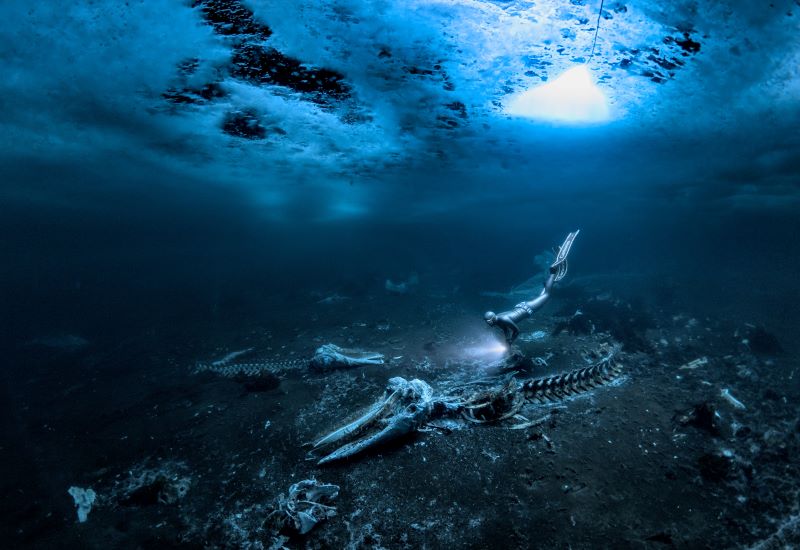
An emotive photograph showing a freediver examining the aftermath of whaling sees
Alex Dawson from Sweden named Underwater Photographer of the Year 2024. Dawson’s
photograph ‘Whale Bones’ triumphed over 6500 underwater pictures entered by underwater
photographers from around the world.
“Whale Bones was photographed in the toughest conditions,” explains chair of judging
panel Alex Mustard, “as a breath-hold diver descends below the Greenland ice sheet to bear
witness to the carcasses. The composition invites us to consider our impact on the great
creatures of this planet. Since the rise of humans, wild animals have declined by 85%. Today,
just 4% of mammals are wildlife, the remaining 96% are humans and our livestock. Our way
needs to change to find a balance with nature.”
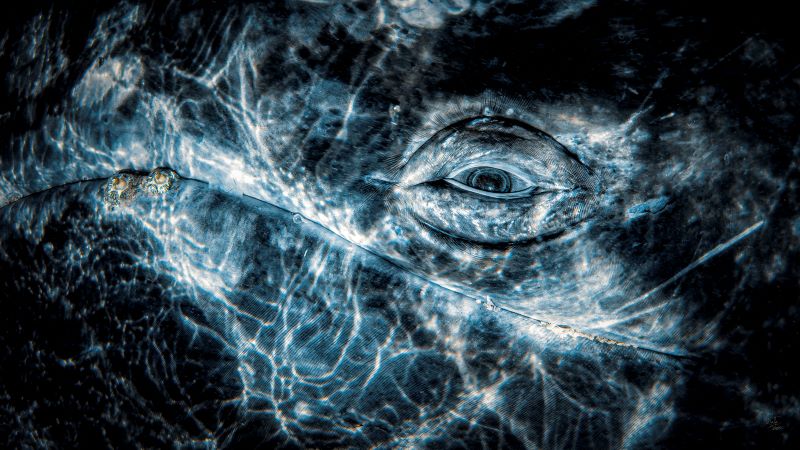
Photo: Rafael
Fernandez Caballero
Whales dominated the winning pictures this year with Spanish photographer Rafael
Fernandez Caballero winning two categories with his revealing photos of these ocean giants:
a close up of a grey whale’s eye and an action shot of a Bryde’s whale engulfing an entire bait
ball, both taken in Magdalena Bay, Baja California, Mexico. Fernandez Caballero took ‘Grey
Whale Connection’ while drifting in a small boat, holding his camera over the side in the water
to photograph the curious whale. ‘The End Of A Baitball’ required Fernandez Caballero to dive
down and be in exactly the right place at the moment the whale lunged. “The photo shows
the high speed attack,” he said, “with the whale engulfing hundreds of kilograms of sardines
in one bite — simply unforgettable to see predation on such a scale.”
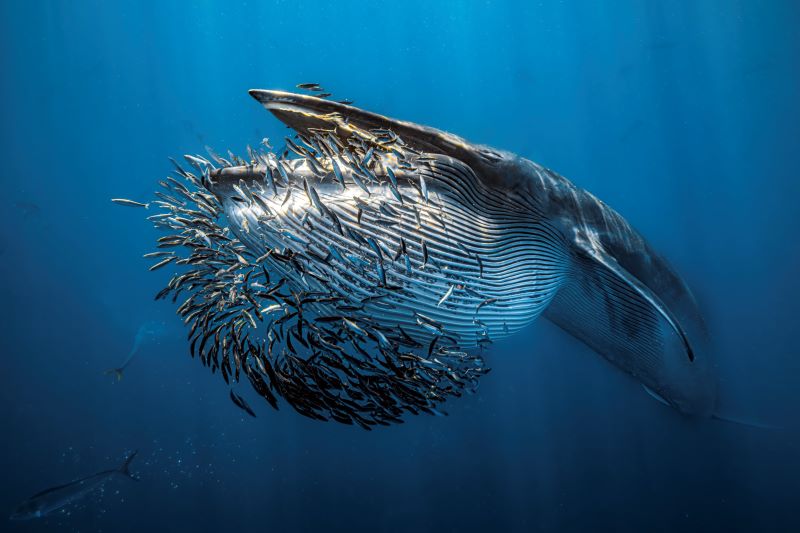
Photo: Rafael
Fernandez Caballero
Lisa Stengel from the United States was named Up & Coming Underwater Photographer of the Year 2024 for her image of a mahi-mahi catching a sardine, in Mexico. Stengel used both a very fast shutter speed and her hearing to catch the moment. “If you listen there’s an enormous amount of sound in the ocean,” she explained. “The action was too fast to see, so I honed in on the sound of the attacks with my camera to capture this special moment.”
“It is such an exciting time in underwater photography because photographers are capturing such amazing new images, by visiting new locations and using the latest cameras,”
commented judge Alex Mustard. “Until this year I’d hardly ever see a photo of a mahi mahi,
now Lisa has photographed one hunting, action that plays out in the blink of an eye.”
The Underwater Photographer of the Year contest is based in the UK, and Jenny Stock,
was named as British Underwater Photographer of the Year 2024 for her image “Star
Attraction”, which finds beauty in species of British wildlife that are often overlooked.
Exploring the west coast of Scotland, Stock explained “in the dark green depths my torch
picked out the vivid colours of a living carpet of thousands of brittle stars, each with a
different pattern. I was happily snapping away, when I spotted this purple sea urchin and I
got really excited.”
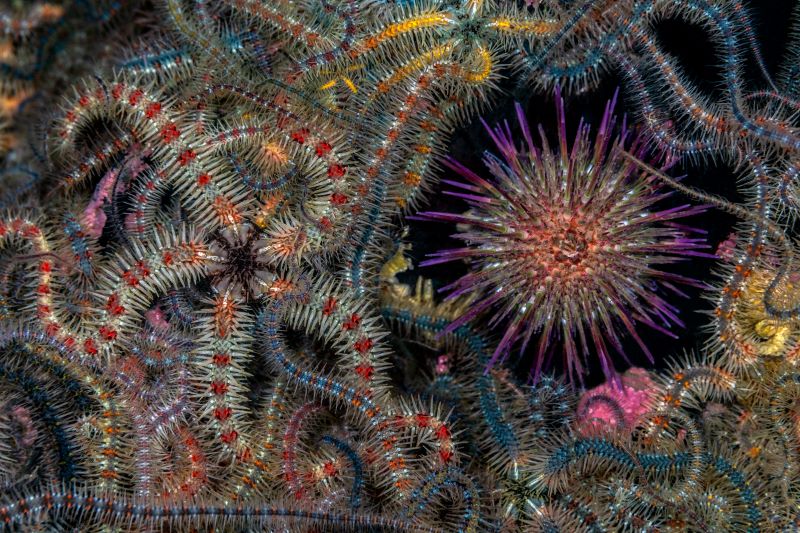
Photo: Jenny Stock
In the same contest, Portuguese photographer, Nuno Sá, was named ‘Save Our Seas
Foundation’ Marine Conservation Photographer of the Year 2024, with his photo ‘Saving
Goliath’, taken in Portugal. Sá’s photo shows beachgoers trying to save a stranded sperm
whale. The picture gives us hope that people do care and want to help the oceans, but also
warns us that bigger changes are needed. “The whale had been struck by a ship and its fate
was sealed,” explains Sá. “An estimated 20,000 whales are killed every year, and many more
injured, after being struck by ships-and few people even realise that it happens.”
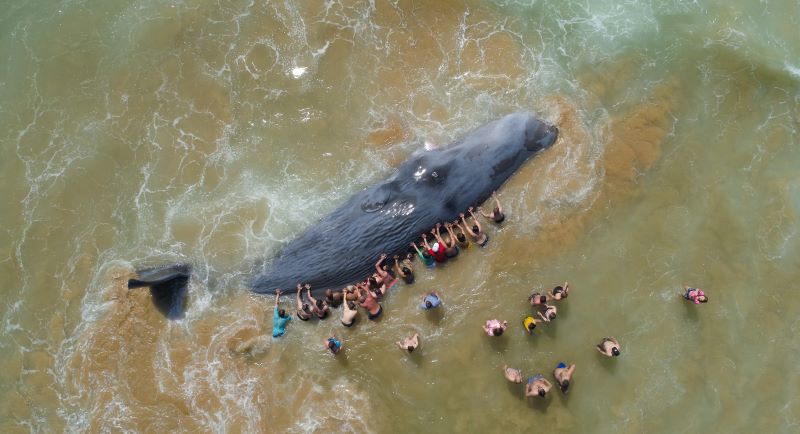
Photo: Nuno Sá
More winning images can be found at www.underwaterphotographeroftheyear.com.
About Underwater Photographer of the Year
Underwater Photographer of the Year is an annual competition, based in the UK, that celebrates photography beneath the surface of the ocean, lakes, rivers and even swimming pools, and attracts entries from all around the world. The contest has 13 categories, testing photographers with themes such as Macro, Wide Angle, Behaviour and Wreck photography, as well as four categories for photos taken specifically in British waters. The winners were announced in an award ceremony in Mayfair, London, hosted by The Crown Estate. This year’s UPY judges were experienced underwater photographers Peter Rowlands, Tobias Friedrich and Dr Alexander Mustard MBE.
Header image: Underwater Photographer of the Year 2024 winner Alex Dawson
News
World’s Best Underwater Photographers Unveil Breathtaking Images at World Shootout 2023
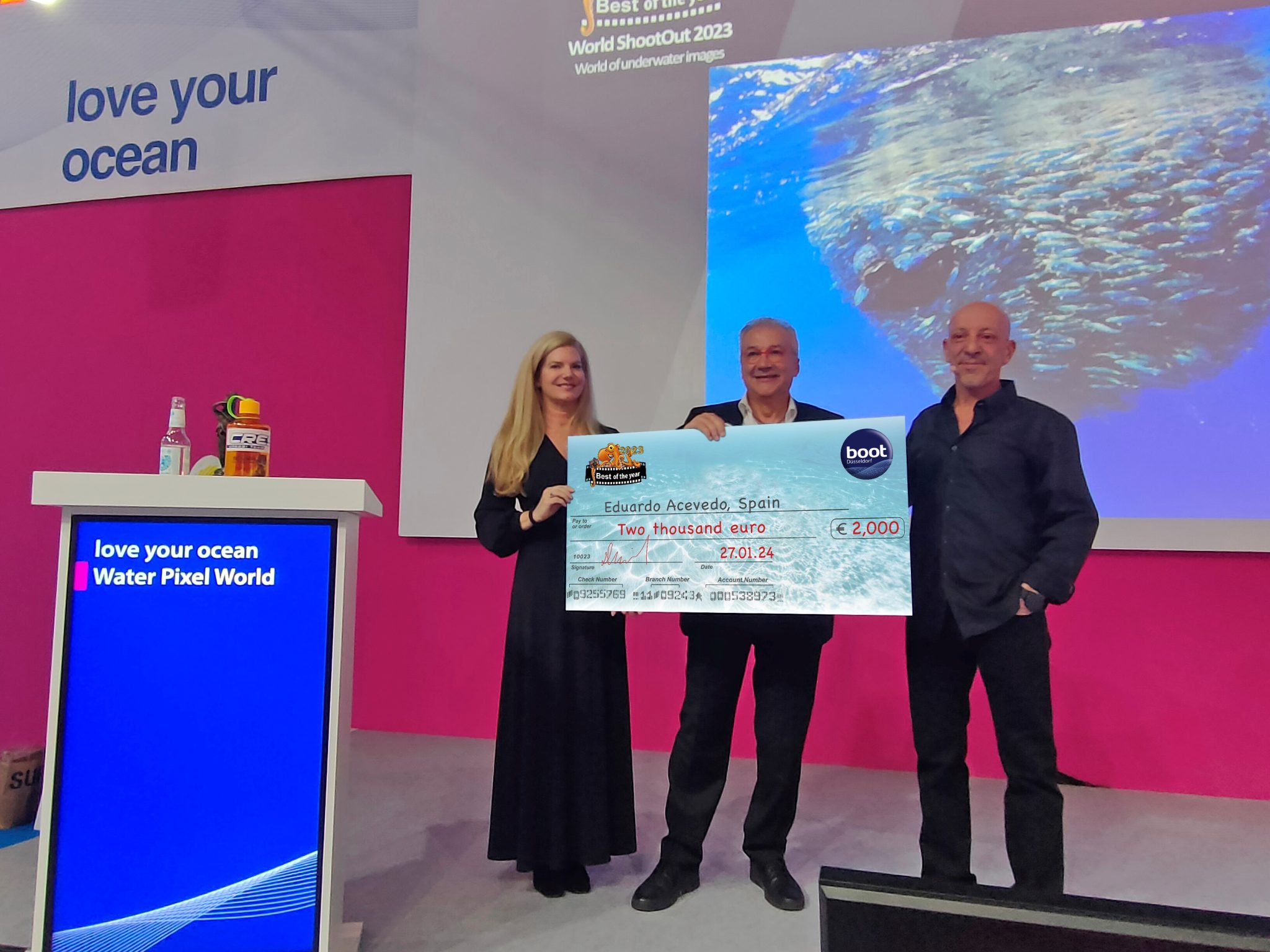
The winners of the prestigious World Shootout 2023 underwater photography competition were announced at this year’s BOOT Show, captivating audiences at the world’s largest diving and water sports exhibition in Dusseldorf, Germany. Hundreds of photographers from 54 countries competed across nine categories, pushing the boundaries of creativity and technical skill.
Grand Prize Winners
- Picture of the Year: Spanish photographer Eduardo Acevedo “secured” the top Honor with the prestigious prize the “boot Dusseldorf Director’s Prize, earning an Andromeda statuette and a €2,000 cash prize.
- Best 5 Images Portfolio: Luc Rooman from Belgium triumphed in this category, winning a dream 4-week diving trip for two to Papua New Guinea, valued at $18,900.
- Amateur Photographer: Alexandra Ceurvorst from the USA impressed the judges with her talent, taking home the 1,000 € cash prize award.
Celebrating Diversity and Innovation
This year’s competition saw 11,680 entries from 964 photographers, showcasing a remarkable spectrum of skills and perspectives. From the intricate wonders of Macro photography to the beauty of “Black Water”, the “Underwater Fashion” category added a touch of artistry and innovation, while the ever-important ” Environmental & Conservation” category served as a powerful reminder of the need to protect these fragile ecosystems.
Looking Ahead: AI and Ocean Conservation
World Shootout founder and producer David Pilosof unveiled an exciting addition for the 2024 competition: this year the Environmental category will be focusing on the impact of plastic on our oceans and future.
This category will embrace the potential of AI or other editing software as a tool to amplify the conservation message.
Entrants will submit campaigns of three original underwater photographs dealing with plastic pollution, along with their final AI assistance processing. This innovative approach encourages artistic expression while raising awareness about a critical environmental issue.
Explore the Stunning Collection
Discover the complete album of competition entries by clicking here.
For Low-resolution photos of finalist entries in eight categories, click here.
-

 News3 months ago
News3 months agoHone your underwater photography skills with Alphamarine Photography at Red Sea Diving Safari in March
-

 News3 months ago
News3 months agoCapturing Critters in Lembeh Underwater Photography Workshop 2024: Event Roundup
-

 Marine Life & Conservation Blogs2 months ago
Marine Life & Conservation Blogs2 months agoCreature Feature: Swell Sharks
-

 Blogs2 months ago
Blogs2 months agoMurex Resorts: Passport to Paradise!
-

 Blogs2 months ago
Blogs2 months agoDiver Discovering Whale Skeletons Beneath Ice Judged World’s Best Underwater Photograph
-

 Gear Reviews2 months ago
Gear Reviews2 months agoGear Review: Oceanic+ Dive Housing for iPhone
-

 Marine Life & Conservation2 months ago
Marine Life & Conservation2 months agoSave the Manatee Club launches brand new webcams at Silver Springs State Park, Florida
-

 News3 months ago
News3 months agoWorld’s Best Underwater Photographers Unveil Breathtaking Images at World Shootout 2023
















